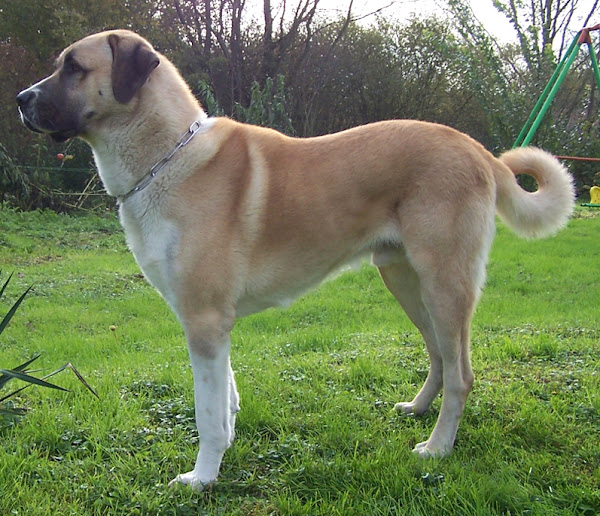The Anatolian Shepherd dog is a beautiful breed of dog. It is also known by some other names such as Karabas, Karabash, Anadolulu Karabas, Anatolian Karabash, Turkish Shepherd Dog, Kangal and Turkish: Anadolu çoban köpegi.
The Anatolian Shepherd dog was originated from Turkey. And the breed was named after the peninsula of Anatolia which forms a large portion of Turkey’s national territory.
Historically, it has been treated as a separate breed from the Kangal Shepherd Dog by many canine registries, but is now generally treated as part of the same breed population.
The Anatolian Shepherd dog descended from ancient livestock guardian dog types that migrated with the transhumance, guarding flocks of sheep from wolves and cheetahs. Dogs of this type probably 6,000 years ago in what is now Turkey.
The Anatolian Shepherd dogs are members of very old breed, probably descended from powerful hunting dogs from Mesopotamia. The breed was developed over time to meet a specific set of circumstances. The most formative were climate, lifestyle and duties.
In the 1970s, breeders in the West became interested in these dogs and began developing the landrace natural breeds as modern breeds by documenting their descent from particular ancestors and writing breed standards. The Anatolian Shepherd Dog was imported from central Turkey into the United Kingdom by author and archaeologist Charmian Hussey.
Australia registered the Anatolian Shepherd Dog breed in 1985, when it was imported as a guard dog for livestock, people, and property. Australia’s expansive sheep and goat enterprises contributed to the breed’s acceptance as a livestock guardian dog beyond Turkey, and developed the sheep and goat guard dog of the Turkish Shepherd into an imposing guard dog of livestock and farm assets for Agricultural and Farming Industry.[1]
Anatolian Shepherd Dog Characteristics
General appearance of the Anatolian Shepherd dog is a tall, rugged and powerful livestock guardian dog with a dense double coat, a broad, strong head. They have well-developed muscular shoulders, and a long tail with slight curl (reaching to the hock) that is carried high and curled over the dog’s back when the dog is alert.
The Anatolian Shepherd dogs have a thick, double coat that is somewhat wiry, and needs to be brushed one or two times a week in warm weather due to excessive shedding. They have very thick hair on their necks to protect their throats. They look as if they are heavier than they actually are, due to the thick coat.
Average height of the mature male Anatolian Shepherd dog is between 29 and 32 inches at the withers, and 28 to 32 inches for females. Average live body weight of the mature males is between 50 and 65 kg, and the females weight is between 40 and 55 kg.

Temperament
The Anatolian Shepherd dogs are rugged, large and very strong. They have good sight and hearing that allow them to protect livestock. They are able to run down a predator with great efficiency, with their high speed and agility.
The Anatolian Shepherd was developed to be independent and forceful, responsible for guarding its master’s flocks without human assistance or direction. These traits make it challenging as a pet; owners of dogs of this breed must socialize the dogs to turn them into appropriate companions. They are intelligent and can learn quickly, but might choose not to obey.
Anatolian Shepherd dogs are very loyal and can be fiercely possessive and protective of their family, stock and territory. They are also bold and confident dogs that do not become overstimulated easily.
They are generally curious but aloof with guests, and do not wan tto make friends with everyone and dislike strangers who are too forward. They are calm and observant of their surroundings and may not go looking for trouble, but may not back down if challenged. An Anatolian that has been agitated may be too angry to be controlled and cannot be stopped on command.
According to Turkish shepherds, three Anatolian Shepherd dogs are capable of overcoming a pack of wolves and injuring one or two of them. These dogs like to roam, as they were bred to travel with their herd and to leave the herd to go hunt for predators before the predators could attack the flock. Therefore, microchipping and tagging pets are recommended.
Anatolian Shepherds are not recommended for life in small quarters. They do well with other animals, including cats if they are introduced while still a puppy and have their own space. They mature between 18 and 30 months. Due to their history, both puppies and adults seem to have little interest in fetching. Rather, they prefer to run and sometimes swim.
Lifespan
Average lifespan of the Anatolian Shepherd dog is between 13 and 15 years.
Feeding
How much a mature dog eats depends on it’s size, age, build, metabolism and activity level. Dogs are individuals, just like people, and they don’t all need the same amount of food. The Anatolian Shepherd dogs are large animals, so their diet should be formulated for a large sized breed with average energy and exercise needs. You can consult with your vet for better recommendation.
Caring
The Anatolian Shepherd dogs are hardy and they can adapt to living outdoors, indoors or both. They should be kept in a securely fenced yard, a fence at least 6 feet tall is required for this large dog breed. Such fence is needed not only for their protection, but also for the protection of dogs or people who might inadvertently enter their turf, which they will defend with all their might.
Because they are naturally wary of new people, animals, and situations, the Anatolian Shepherd must be socialized right from puppyhood. Obedience training and consistent leadership are also essential, because the Anatolian is so strong-willed. This dog has their own ideas, and they won’t cater to their owner’s every whim.
The Anatolian Shepherd will guard and protect without any protection training; in fact, attack training is not recommended for this breed. Their protective nature grows as they matures; by the time they’re about 18 months old, they usually voluntarily take on the role of guardian.
Health
The Anatolian Shepherd dogs are generally healthy. But like all other dog breeds, they are also prone to certain health conditions.
Their common health problems include hip dysplasia, elbow dysplasia, hypothyroidism, or von Willebrand’s disease.
| Breed Name | Anatolian Shepherd |
| Other Names | Karabas, Karabash, Anadolulu Karabas, Anatolian Karabash, Turkish Shepherd Dog, Kangal and Turkish: Anadolu çoban köpegi |
| Breed Size | Large |
| Height | 29 and 32 inches at the withers for males, and 28 to 32 inches for females |
| Weight | between 50 and 65 kg for males, and the females weight is between 40 and 55 kg |
| Good as pets | Yes |
| Climate Tolerance | All climates |
| Color | Shades of brown |
| Lifespan | Between 13 and 15 years |
| Good for children | Yes |
| Rarity | Common |
| Country of Origin | Turkey |






